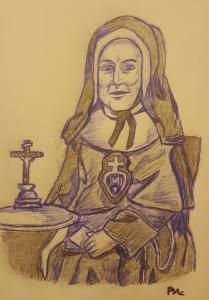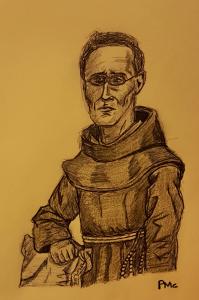![catholicworld76pauluoft_0520[1]](https://wp-media.patheos.com/blogs/sites/224/2013/11/catholicworld76pauluoft_05201-184x300.jpg)
Just at this time the Passionist Fathers are celebrating the Golden Jubilee of the Order in America. The festivities commemorate of the event are being held in the Church of St. Paul of the Cross, Pittsburg, S.S. Pa., on the spot where the work of this order in this country began fifty years ago. The Jubilee suggests the following notice of the Order and of its work in America.
The Order was founded by Paul Francis Danei, or St. Paul of the Cross (1694-1775). From childhood he had but one thought, and that was of Our Lord’s Sacred Passion. In vision, he had once beheld Our Blessed Lady clothed in the garb now worn by the Passionists—a black robe, with a heart attached. The heart is white, and in the centre the name of Jesus and the characters of the Passion are included. Paul was told that the garment was one of mourning for the death of Our Lord, and that the white heart indicated how pure the heart should be to have written upon it the name of Jesus and characters of His sacred Passion.
“England’s eldest daughter beyond the sea” came within the range of the prayer and of the charity of St. Paul of the Cross. So thought Pope Pius IX (1846-1878) and Father Anthony of St. James, the General of the Order. The work of the Fathers in England had been watched closely by Rome, and their success had paved the way for a venture in America. Here, too, they were destined to bring many souls to “the one fold of Christ.” This was brought about by the Right Rev. Michael O’Connor, first Bishop of Pittsburg, Pa.
In 1852 Bishop O’Connor visited Rome. He asked the Father General of the Passionists to give him a colony to establish a house of the Order in his far-off diocese. The general readily acceded to this request, and selected Father Anthony Calandri, Albinus Magno, Stanislaus Perezki, and Brother Lawrence for this mission. The bishop most kindly offered to defray the expenses of the expedition, and to keep the Fathers in his own home till they had learned the language and become acquainted with the genius of the American people. Furthermore, he proffered them every assistance in erecting a house and a church in his diocese, as their rule required.
![Bishop_Michael_O'Connor[1]](https://wp-media.patheos.com/blogs/sites/224/2013/11/Bishop_Michael_OConnor1-241x300.png)
Father Stanislaus, though a Pole, spoke German well, and the Bishop placed him at once in charge of St. Michael’s congregation, in the South Side, or Birmingham, as it was then called. The other Fathers he kept with himself. On the hilltop, high above St. Michael’s Church, the Bishop gave the Fathers the site on which their monastery and church are built. The corner-stone of the new monastery was laid August 7th, 1853, and the monastery dedicated June 4th of the following year. The Bishop’s hopes were at last fulfilled. He had brought the Passionists to America; he had taught them the language and ways of the country; he had given them the ground on which to build; he had blessed and furnished their new home; he had been their friend and adviser; and the grateful tribute of Father Anthony, the first superior, to the Bishop on this occasion was touchingly beautiful. The Fathers labored not only in conducting missions and retreats, but in every department of priestly work and in every portion of the diocese, to prove their profound appreciation of the kindness of their great friend and benefactor, the Bishop.
![catholicworld76pauluoft_0518[1]](https://wp-media.patheos.com/blogs/sites/224/2013/11/catholicworld76pauluoft_05181-300x257.jpg)
The founders of the Order in America had been formed by a master-hand. They were men of God; they were intensely devoted to their blessed father, St. Paul of the Cross. Like him, they blended in their characters the sweetness of St. Francis de Sales with much of the austerity of St. Francis of Assisi. They awakened in the American heart a passion of enthusiasm for their saintly founder and his work. They held to his rule and spirit with uncompromising firmness, and yet they were all things to all men. They identified themselves with the country; they were one with its people; and with rare humility and kindly grace, they chose for themselves the last place, when they had trained good men to fill the first.
The order grew with astonishing rapidity, and people marveled at this foreign plant attaining to native growth in American soil. But this simply verified the saying of Benedict XIV in giving it his sovereign approval: “It is the last order in the Church; but it might have been the first;” for its rule and spirit are adapted to all times and every clime. These men enshrined themselves in the heart of all. They have left after them sacred memories which endear them to us, and now, with grateful hearts, we recall them and call them blessed. Two alone remain, Father Guido and the Very Rev. Father John Baptist Baudinelli. In 1899 the latter was recalled to Rome to represent the American Province as second consultor general. He returned to America to preside, in the father general’s name, at the chapter held last August in Pittsburg, and he is still in the country to be present at the Golden Jubilee of the Order in America.
Since the foundation made in Pittsburg, fifty years ago, houses have been established in Dunkirk, N.Y.; West Hoboken, N.J.; Baltimore, Md.; Cincinnati, Ohio; Louisville, Ky.; St. Louis, Mo.; St. Paul, Kas.; and recently in Scranton, Pa. In these houses the rule is observed as strictly as in Rome itself, and this is done notwithstanding the great demand for the service of the Fathers. That little band of men from Italy, without funds and without influence, save that of the illustrious Bishop who brought them hither; these men entirely unacquainted with the language and ways of the country, but with magnificent faith and boundless trust in the good Providence of God; these simple, kindly, unassuming men, began their work fifty years ago—and how well and wisely they builded, fifty years of achievement bears ample testimony. To be sure, they were highly favored by the excellent prelates who invited them to locate in their dioceses; but still what these men accomplished is simply astounding.
It may be said that these Fathers began the work of “home missions” in America; and what is more remarkable, missions to non-Catholics. In Boston, for instance, as early as 1862, after a mission to the Catholic people of St. Joseph’s parish, a week’s mission was given by Father Gaudentius to non-Catholics. Hence, when the Paulist Fathers inaugurated this good work on its present lines, the Passionists were in full sympathy with them. Devotion to Our Lord’s sacred Passion is the great feature of the work of the Order, and the secret of its success in the missionary field. Not as a mere sentiment, but in its practical application to the duties and relations of every-day life, its lessons for the mind, for the heart, for the whole career of man. Through the prayer of their sainted Founder, the Passionist Fathers seem to have a special blessing attached to their missionary work, not only in England but in our own beloved land. May this work go on increasing to the end, ever assuming proportions more magnificent to the glory of God and the honor of His Church, proving ever more the efficacy of the prayer of Saint Paul of the Cross!
NOTE: The above article has been slightly abridged in the interest of blogging brevity.











